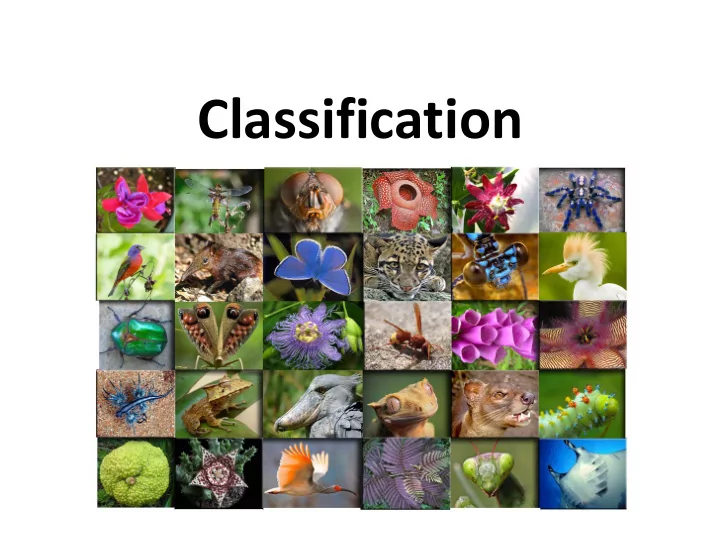

Classification
Species of Organisms • 13 billion known species of organisms • This represents only 5% of all organisms that have ever lived on Earth • New organisms are still being found and identified – where?
What is classification? • Classification is the arrangement of organisms into orderly groups based on their similarities • Also known as taxonomy • Taxonomists are scientists that identify and name organisms
Benefits of Classifying Organisms • Accurately and uniformly names organisms • Prevents misnomers Example: Starfish and jellyfish are NOT fish • Uses the same language (mostly Latin) for all names
Using Different Languages for Names
Latin Names Minimize Confusion
Early Taxonomists
Aristotle • The first taxonomist (2000 years ago) • Divided organisms into plants and animals • Further subdivided them by their habitat – land, sea or air dwellers
John Ray • John Ray (botanist) was the first to use Latin for naming organisms • Names consisted on very long descriptions telling many details about the plant
Carolus Linnaeus “Father of Taxonomy” • 18 th century taxonomist (1707-1778) • Classified organisms by their structure • Developed the modern system of naming organisms known as binomial nomenclature – Two word name consisting of the genus and species
Binomial Nomenclature • Genus species ( capitalize genus, but NOT species) • Species are identified by their common name and scientific name • International Code for Binomial Nomenclature – rules for naming Turdus American Robin migratorius
Binomial Nomenclature • Which two bears are most closely related?
Classification Groups • Taxon (taxa-plural) is a category into which related organisms are placed • Hierarchy of groups (taxa) from broadest to most specific
Red Fox
Mnemonic Device • D readful • K ing • P hilip • C ame • O ver • F or • G ood • S oup
Basis for Modern Taxonomy • Classification is based on evolutionary relationships • Homologous structures (same internal structure, different function), similar embryonic development, and molecular similarities in DNA, RNA, amino acid sequences or proteins
Homologous Structures
Cladogram
Rhesus Human Chimpanzee Monkey • Animalia • Animalia • Animalia • Chordata • Chordata • Chordata • Mammalia • Mammalia • Mammalia • Primates • Primates • Primates • Hominidae • Hominidae • Cercopithecidae • Homo • Pan • Macaca • H. sapien • P. troglodytes • M. mulatta
Dichotomous Keying • Used to identify organisms • Identifying characteristics are given in pairs • Read both characteristics and either go to another set of characteristics OR identify the organism Let’s Try It!
Recommend
More recommend